Past Exhibitions: 2001-2009
The Luther W. Brady, M.D. Collection of 20th Century Works on Paper, The Picker Art Gallery, Colgate University
March 7-30, 2001
Annual Awards Show
April 5-25, 2001
Media and Public Affairs Building, 2nd floor cases
The Birth of Two Democracies
May 30-July 13, 2001
Ernest W. Michel, executive vice president emeritus, UJA-Federation of New York, a German-born survivor whose own life story from the fires of Kristallnacht to the highest echelons of American Jewish philanthropy, is intertwined with this unique historical Judaica exhibit. “The Promise” is a collection of unique and historic documents, photos, autographed artifacts and other personal items that Michel began gathering shortly after he came to the U.S. “Having been fortunate to survive and privileged to play a role, through my work with UJA and UJA-Federation as a professional, I am proud to share my collection with all,” said Michel.
Cover-ing the Campaign
September 12-21, 2001
“Cover-ing the Campaign,” an exhibition featuring magazine covers that depict the 2000 presidential campaign and election, showcased the media’s portrayal of the candidates and the events that shaped the closest election in recent history. The exhibit was organized into four sections: “The General Election” featuring both candidates, “George W. Bush,” “Albert Gore,” and “The Post-Election Period” highlighting the ballot controversy and general confusion that continued for 36 days after the American people cast their votes. This exhibit offered the opportunity to revisit the creative images generated by art directors, editors, photographers, illustrators, and graphic designers during the election campaign
Ocean of Ink, River of Fire
October 10-November 30, 2001
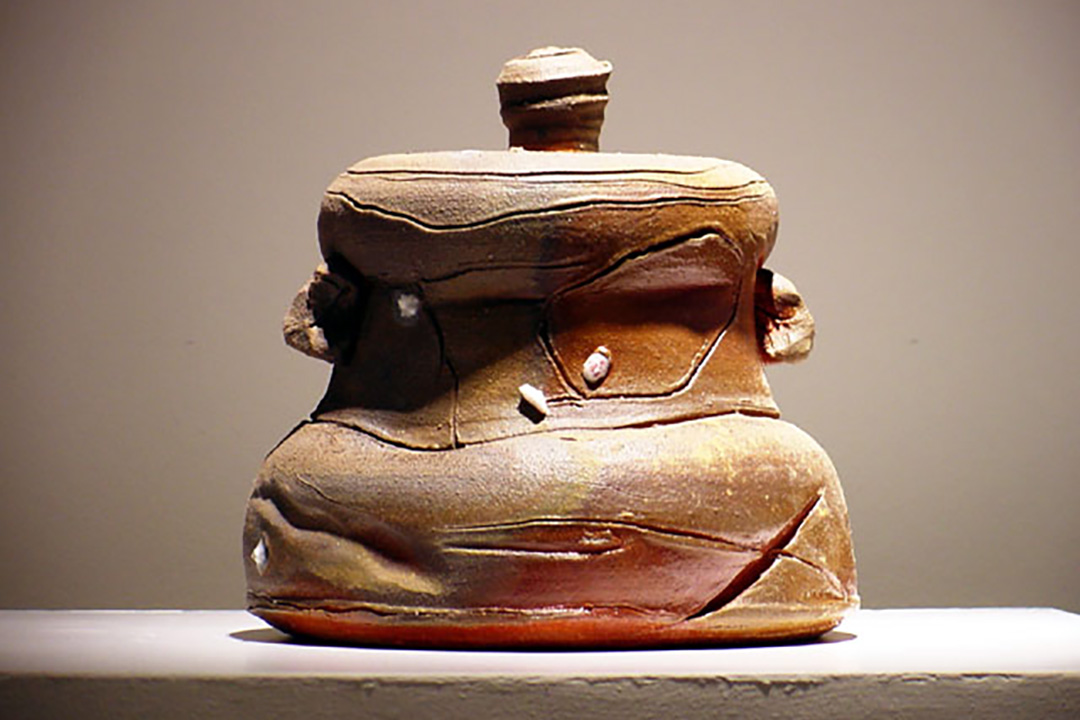
Randy Edmonson, Lidded Jar, stoneware with feldspar inclusions, 8" h. x 8" diam. Courtesy of the artist.
In participation with National Arts and Humanities month (October), GW's University Art Gallery exhibited Ocean of Ink, River of Fire, which embodied the spirit of creativity, culture and community practiced in the museum world.
The exhibition featured painting and calligraphy by Stephen Addiss and ceramics by Randy Edmonson, Scott Meredith, Cricket Edmonson, John Jessiman and Stephen Addiss.
Don Quijote: The Visible and Invisible
December 12, 2001-February 8, 2002

Francisco Castillo, Don Quijote and Sancho, 1981, watercolor on paper, 13-1/2" x 22". Collection of Ms. Angela Castillo via The Cultural Office of the Embassy of Spain
Watercolors, drawings and prints by Francisco Castillo on the subject of Miguel de Cervantes’ novel, Don Quijote and featuring sketches and a model for the sculpture, Don Quijote Deconstructed by Juan Romero de Terreros.
Epic Paintings
March 25-April 5, 2002
Large-scale abstract paintings by Nancy Graves, Howard Hodgkin, Hans Hofmann, Jules Olitski, Sean Scully and John Walker from the collection of Luther W. Brady, M.D.
“Epic Paintings” was the inaugural exhibition for the newly named, Luther W. Brady Art Gallery at The George Washington University.
Annual Awards Show
April 18-May 3, 2002
Presidential Scholars in the Arts
June 26-July 17, 2002
The exhibit presented works by 2002 Presidential Scholars, featuring an engaging young film, First Kiss by Antonio Ganguzza Campos, oversized alienated images of people painted by Hilary Catherine Jacks and delicate ceramic and glass vessels created by Cara Emily Levine. Constance J. Parng writes of fragmentation and childhood in her excerpt from The Fire-Feeding Heartbeat of Tap Water Rain.
Nine students were honored for their work in film and video, photography, visual arts, and writing and exemplary works
America Through the CBS Eye
September 3-October 8, 2002
Media and Public Affairs Building, 2nd floor cases
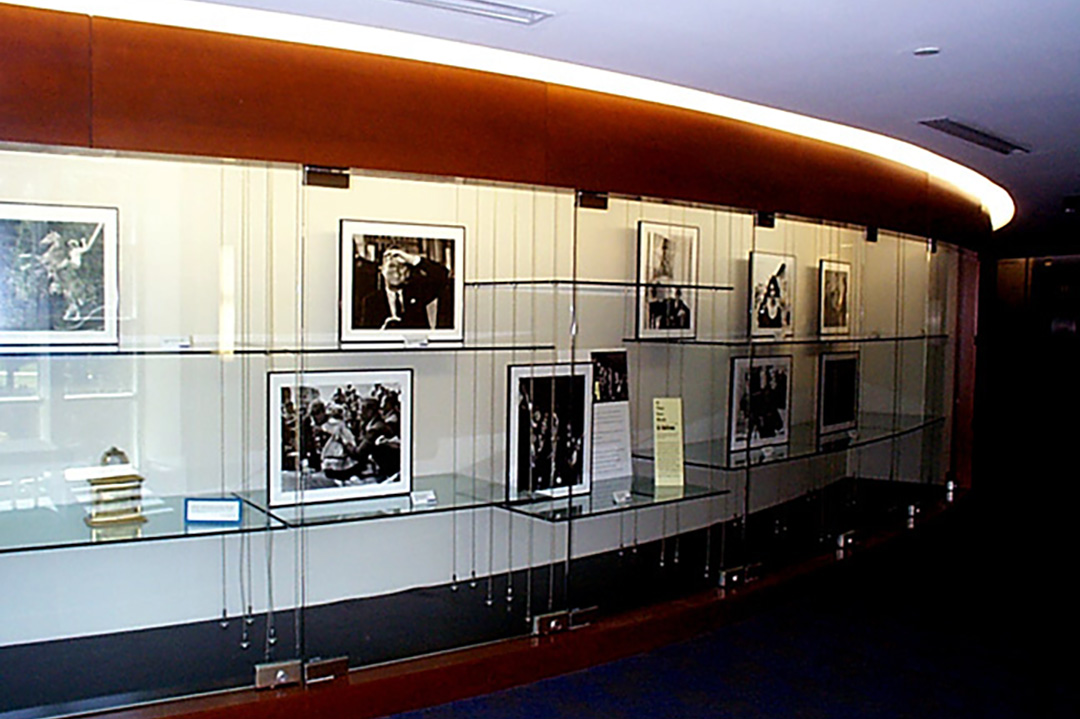
Installation view of the exhibition
In celebration of 75 years of CBS broadcasting history, The George Washington University presented “America Through the CBS Eye”, a traveling exhibition of memorable images taken by CBS photographers as far back as 1928, when CBS first began broadcasting as a radio network.
About 120 photographs were displayed in the Brady Gallery and distributed among cases on the first and second floor of the Media and Public Affairs Building. They represented a sampling of images taken by CBS photographers contained in the CBS Entertainment Archives and record entertainers and personalities that have come into our homes over the past seventy years.
2nd Annual Student Show
October 29-November 27, 2002
An Eastern and Western Exchange
October 21, 2002-February 20, 2003
Media and Public Affairs Building, 2nd floor cases
A Perfect World
October 30-December 6, 2002
Imagine talking candidly with over 50 prominent Americans, asking each of them to describe their vision of an ideal world. Imagine then asking them to paint a picture of the world they have just described. Journalist Debra Trione did just that, and compiled the results into her book entitled, A Perfect World: Words and Paintings from Over 50 of America’s Most Powerful People. Thirty-six of these images and their accompanying texts are exhibited in “A Perfect World” at the Luther W. Brady Art Gallery, including depictions by such distinguished figures as James Carville, Alan Dershowitz, Candace Gingrich, Patricia Ireland, Knight Kiplinger and Eleanor Holmes Norton.
Il Illo Tempore: Recent Paintings and Projects by Vicente Pascual
February 6-28, 2003
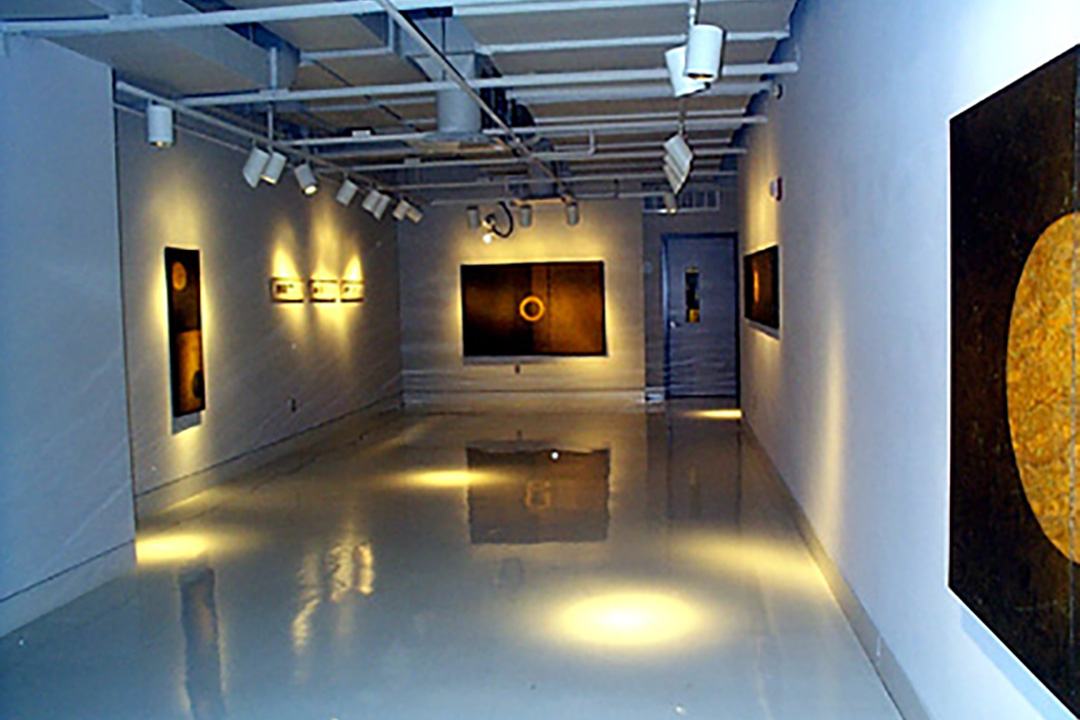
Installation view of the exhibition
“In Illo Tempore” refers to a Latin phrase from the Gospels, and is similar to the English “Once upon a time…” This general sense of being out of the mainstream suggests something eternal, which is the essence of Vicente Pascual’s approach to geometric abstraction in his acrylic and ink paintings. Inspired by the rugged Roman walls of his birthplace, the Aragonese city of Zaragoza, Pascual creates paintings that engage the built environment. Architectural texture and form influence Pascual’s painted surfaces and are characterized in his color palette, which brings to mind sand, earth and soil. Pascual’s work favors centralized arrangements of extremely simple geometric forms on generally monochromatic grounds. His paintings represent a harmonious union between rigor and freedom.
Campus Icons
February 22-April 2, 2003
Media and Public Affairs Building, 2nd floor cases
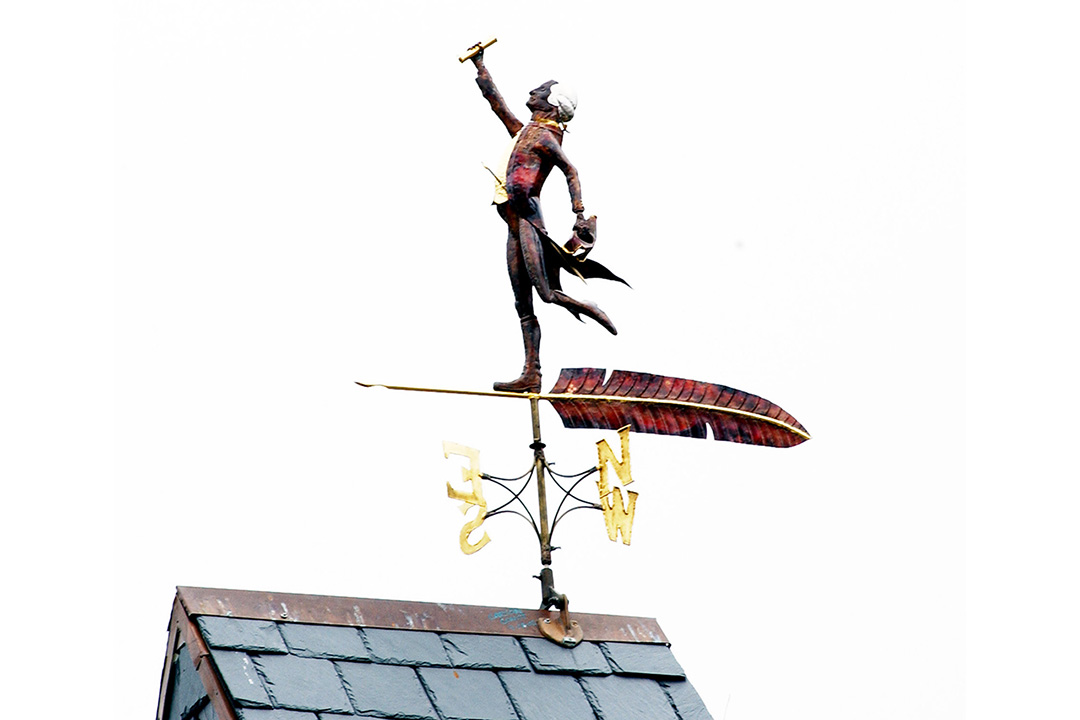
Travis Tuck, George Washington weathervane,
The exhibit, Campus Icons, highlighted a selection of public sculptures that we pass on campus everyday. It strove to offer information on the history and provenance of each sculpture and to celebrate the process of the artist and donor involvement in the enhancement of the physical environment of the campus.
The idea of an icon is central to this exhibition. The sculptures situated on campus have become important and enduring symbols of the University and its growth. The George Washington University campus has been enlivened by plaques, memorials and monuments enhancing the physical campus environment, their permanence adding a sense of familiarity and comfort to the area.
Khorjin and Mafrash from U.S. Collections
April 10-25, 2003

Image Caption (Optional)
An exhibition of approximately 60 extraordinarily rare and beautiful antique khorjin (two-pouched saddlebags) and mafrash (box-like storage and transport bags) from Northwest Persia used for the transport of personal belongings and bedding. These rare bags often represent the epitome of personal Near Eastern textile art in the 19th century. Many objects are complete with original backs, conveying information rarely seen in any exhibition of like material. Others are the decorated faces of the bags. The objects illustrate several structural techniques used in the region: sumak wrapping, kilim and pile, among others.
Clarice Smith: Paintings
May 1-30, 2003

Image Caption (Optional)
Clarice Smith captured the essence of place, individuality of a subject and mood of the moment in her nineteen paintings in this exhibit. She has stated, “I paint the world I live in, the things I know,” such as the dynamism of a horse in motion and the heavy atmosphere surrounding a particular road in the Scottish Highlands. Smith infuses conventional stylistic approaches to painting and composition with touches of her own invention. Patterning found in nature, people and objects is of paramount interest to Smith, and serves as the springboard for her compositions.
In her career of almost 30 years of painting, the visual artist remains a passionate traveler and student of art history. Smith received her Bachelor of Arts (1976) and Master of Fine Arts (1979) degrees from GW. She was on the faculty of the Department of Fine Arts and Art History from 1980 to 1987. A seven-museum tour of her work Clarice Smith: Remembered Moments, included a stop at GW’s Dimock Gallery in 1986. The Israel Museum, Jerusalem, exhibited Clarice Smith: Paintings in 1988, and her work has been included in exhibitions at The National Museum of Women in the Arts, Washington, D.C.
Hannelore Baron: Works from 1969-1987
Organized by Smitsonian Institute Traveling Exhibition Service
October 18-November 14, 2003

Installation view of the exhibition
The mission of this exhibit was to increase understanding and tolerance through cultural exchange, specifically through exhibiting this internationally renowned artist who found inspiration through spiritual, written, and visual sources.
Catalogue Excerpt:
Using materials that felt familiar from use – scraps of fabric, wood, string, wire, pieces from children’s games, printed labels and other discarded items – artist Hannelore Baron constructed intimately scaled works that offer glimpses into history, the human condition and the artist’s past. Baron is known for the highly personal, intimately sized abstract collages and box constructions that she began exhibiting in the last 1960s. During her life, the ideas expressed in her work grew more complex, introspective and personal; while at the same time they communicated a universal message about nationalism, war and cruelty.
The exhibit was organized by the Smithsonian Institution Traveling Exhibition Service in cooperation with the Estate of Hannelore Baron and Manny Silverman Gallery in Los Angeles.
Arresting Images
November 19, 2003-January 16, 2004

Image Caption (Optional)
The over 40 photographic images in this show were been brought together by a professional philosopher, Peter Caws, GW University Professor of Philosophy, working hand in hand with a professional photographer, Nancy Breslin (M.F.A., University of Delaware, 2000). They were chosen with a specific idea in mind. The idea is to persuade the viewer not just to stop briefly in front of each image and then pass on, but at least in some cases if not in all to come and rest (to be “arrested”): to detach for the moment from the environment, from past and future; to confront the images in a wide-awake and questioning way free of expectations; to let them start chains of reflection and inquiry that will not end here but will persist and spill over into other aspects of life.
Tunisian Paintings: A Cultural Perspective
January 29-March 5, 2004
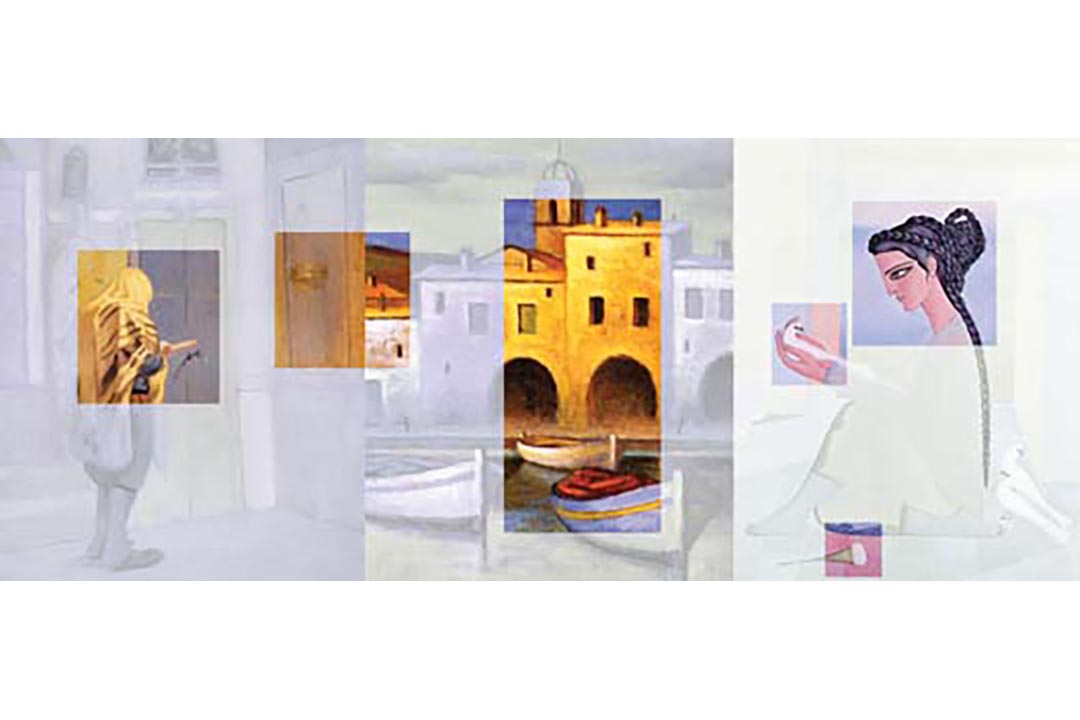
This collection of paintings and works on paper celebrated Tunisia’s traditions of tolerance and openness as depicted through a century of art.
Including the works of such pioneering artists as Abdelaziz Gorgi, Jallel Ben Abdallah, Jules Lellouche and Pierre Boucherle, the exhibit explored the development of a unique artistic tradition, which combined European influences with traditional indigenous elements. The situation of this Mediterranean country as a crossroads of European, North African, Islamic and Jewish cultures is reflected in the variety and richness of its art.
This exhibition was supported by the Milton and Miriam Handler Foundation.
Annual Awards Show
April 8-30, 2004
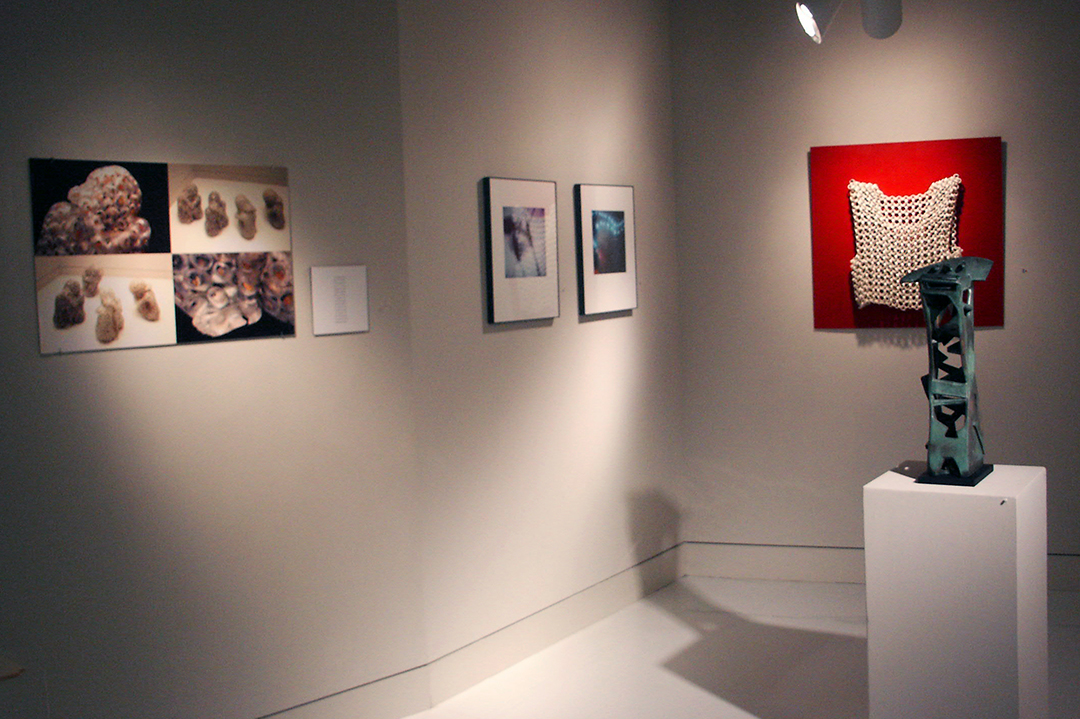
Installation view of the exhibition
Approximately 40 works by emerging student artists were featured in the Annual Awards Show. The exhibition juxtaposed traditional pieces alongside more innovative works. For example, the paintings displayed a range of styles from the colorful dabs of paint in Anne Letterer’s Bench People, to the sweeping application of oil stick and collage on paper in Valentine Wolly’s Memories. The featured photographs also demonstrated different styles through an exploration of the technical possibilities of photography. Pamela Nabholz’s images are painterly and ethereal, while Danielle DiRosario’s photographs of the human body border on abstraction. Particularly remarkable was the variety of ceramics in the exhibition. The works in clay are sculptural and engaging. Shelley Stevens’ work, for example, plays off the relationship between found pieces of wood and complementary ceramics.
Awards were given for work in aquarelle painting, ceramics, drawing, painting, photography, printmaking and sculpture. The judge was George Hemphill, owner of Hemphill Fine Arts, who also selected the works for inclusion in the exhibition.
Oscar Bluemner: A Daughter's Legacy Selections from the Vera Bluemner Kouba Collections, Stetson University
May 13-June 30, 2004
Landscapes of everyday modern society – mills, factories, small farms, unkempt suburbs – portrayed in brilliant colors and a variety of media, filled GW’s Luther W. Brady Art Gallery for one of the most comprehensive exhibits of the work of painter Oscar Bluemner ever presented. Bluemner (1867-1938) was one of the first Modernists, reaching his peak in the late 1910s to mid-1930s. He described his subjects as “the intimate landscape of our common surroundings…the things and scenes most closely interwoven with the progress of life.”
Many of the works in this exhibition have not been seen since the artist’s death in 1938. They are part of more than 1,000 pieces of Bluemner’s work bequeathed to Stetson University in 1997 by his daughter, Vera Bluemner Kouba. The original exhibition featured 86 pieces from every period of Bluemner’s production, ranging from pencil and charcoal studies, annotated by the artist, to major works in watercolor and oil. They were selected by Curator Roberta Smith Favis to demonstrate the depth and breadth of the Vera Bluemner Kouba Collection, as well as of the beauty and quality of the artwork.
Fritz Scholder
September 7-24, 2004

Fritz Scholder, Indian with Heart,
Fritz Scholder displayed works by the notable Native American painter, printmaker and sculptor. This exhibition opened concurrently with the opening of the National Museum of the American Indian on the Mall. The works on view were on loan from The Picker Art Gallery, Colgate University and the private collection of Luther W. Brady, M.D.
The George Washington University Community Collects
October 13-December 10, 2004

Image Caption (Optional)Installation view of the exhibition
Normally private collectors’ works can only be seen by their friends and family. However, the upcoming exhibition at GW’s Luther W. Brady Art Gallery will enable the public to glimpse the diversity of the collections from some of the gallery’s patrons and members of the GW community. The continued operation of the Luther W. Brady Art Gallery is made possible through the generosity of its patrons, particularly the Friends of the Luther W. Brady Art Gallery. While these donors support public access to art through the efforts of the gallery, they also maintain their own art collections.
The exhibition represents a small sampling of the collections of the gallery’s patrons and members of the GW community. Many collectors have a variety of interests. For example, Dr. Seymour and Ruth R. Perlin are represented not only by a print by Alberto Giacometti, but also by several embroidered Chinese collars. Other collectors, such as Richard Isaacson who collects Central Asian textiles, focus on one topic. The Uzbek saddlebag known as a “Khorjin,” lent by Isaacson, demonstrates the craftsmanship and esteem that culture devotes to its textiles. For this exhibition, Dr. and Mrs. S. Lifschutz have lent not only pieces they have collected, such as a table and chair by George Nakashima, but also works by Phyllis Lifschutz herself. These watercolors, which depict scenes of nature, evoke the works of J.M.W. Turner.
Taken together, the selections included in The George Washington University Community Collects indicate the variety of tastes and motivations behind collecting. The patrons and GW community members have the opportunity to showcase their work, while the wider public has the rare chance to view these normally hidden treasures.
Cultural Heritage Through Ceramics: An Exhibition of Lawrence M. Rozanski Korean Ceramics Collection
October 14-December 14, 2004
Media and Public Affairs Building, 2nd floor cases

Installation view of the exhibition
An exhibition of selected ancient Korean ceramics, private collection of Lawrence Rozanski, allows us to present a display of formidable and beautiful objects never before seen by the general public. Lawrence Rozanski collected these works after the Korean War during and after his service there. As he lived in the country, he learned and appreciated the quality of Korean art forms. He developed a knowledge of the bold and the distinctive designs, and the connoisseurship necessary to assemble a group of pieces with a discerning eye.
Enlightened Thinking, Lasting Appeal
February 3-March 11, 2005

Image Caption (Optional)
The Age of Enlightenment represents a critical time in American history when the country was established and the culture was formed. During the century that followed, the early days of our nation were glorified and romanticized. This exhibition examined how these interpretations continue to shape our understanding of the past. The works include pieces on loan from the Daughters of the American Revolution Museum as well as works from the GW Permanent Collection.
Annual Awards Show
April 7-29, 2005
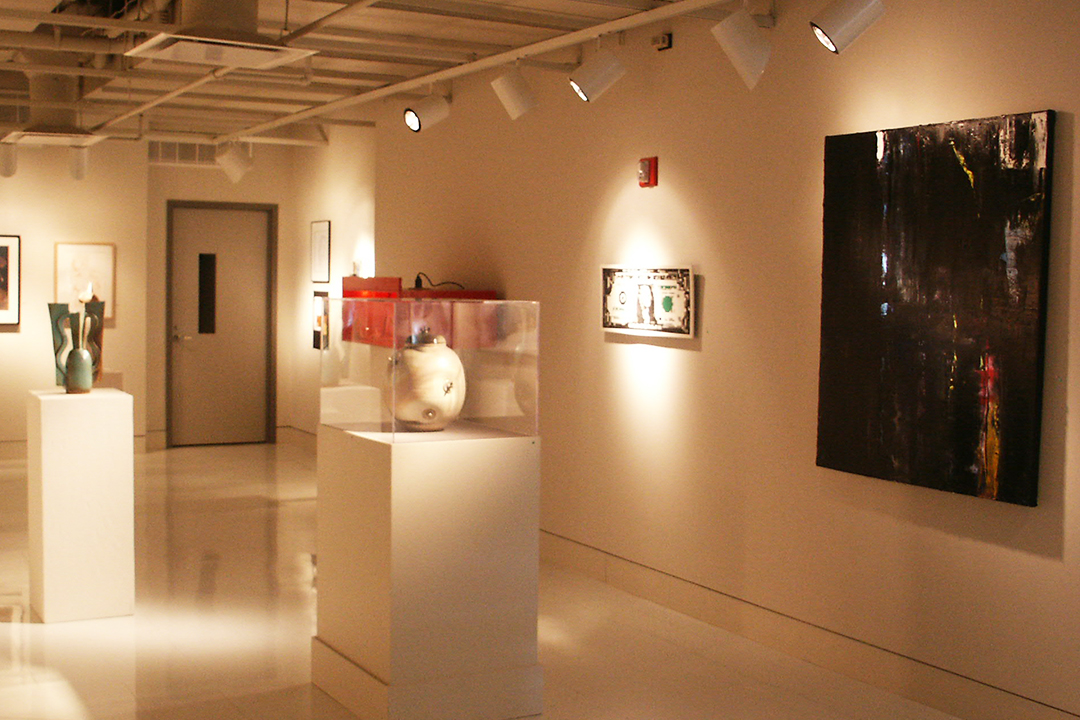
Installation view of the exhibition
A ballerina’s toe shoes are envisioned tapping inside an impossibly small box, Lego blocks are assembled to create an image of the dollar bill, and Barbie doll parts are arranged inside a red tableaux. These are among the 30 works by emerging student artists featured in the Annual Awards Show at GW’s Luther W. Brady Art Gallery. The exhibition juxtaposes traditional pieces alongside more innovative works. For example, there are a number of technically precise, realistic drawings including a riveting life-like self portrait by Christopher Locke, along with abstract paintings, evidenced by the swirls of color on Valentine Wolly’s large diptych and the hints of brilliant color through the stark black background on Nicholas Moses’ works. The featured photographs also demonstrate different styles through an exploration of the technical possibilities of photography. Pamela Nabholz’s images are painterly and ethereal, while the focus and resolution in Diana Rodrigues’ photographs make the subjects appear three-dimensional. The show also features a number of works incorporating new media, including flash animation and a video installation.
Awards have been given for work in aquarelle painting, ceramics, design, drawing, painting, photography, and sculpture. David Furchgott, president and CEO of International Arts and Artists, served as this year’s judge and selected the works for inclusion in the exhibition.
Intimate Treasurers: The 18th Biennial Exhibition of the Washington Print Club Members' Prints
May 12-June 3, 2005

Image Caption (Optional)
This year’s biennial exhibition, the 18th from the collections of members of the Washington Print Club, presents small works of art on paper that are visually arresting and technically adept at evoking a universal theme within a small format. The approximately 60 prints on display will include works by old masters and contemporary artists. The exhibition features prints by John Sloan, Rockwell Kent, and James Abbott McNeil Whistler, along with prints by lesser known artists such as Hans Sebald Beham, Clinton Adams, and Elizabeth Catlett. Often the joy of collecting prints is in the “hunt.” There is a pristine Whistler print in the show that had an unusual provenance…it was discovered at a flea market amidst a box of frames.
All of these works are drawings or original prints that the artist was involved in making, as opposed to photographic and mechanical reproductions. While most of the works in the show are by major American and European artists, a few of the gems are by artists who resided in Washington, such as Prentiss Taylor, Jacob Kainen, Lou Stovall, and Charles Ritchie.
John Walker: Works on Paper
September 6-October 28, 2005

Installation view of the exhibition
a collection of 24 expressionistic landscapes, including both large prints and smaller sketches. Walker’s characteristically broad, painterly brushstrokes and bold color palette emphasize the great force of nature behind his chosen subject matter, the wooded mountains of Colorado and the coastal area of Maine, where he has owned a home for many years. Many of these works were executed out of doors, which contributes to the feeling of immediacy in the brushwork and the constant flux of shapes, lines and colors.
Imagination and Knowledge: Centennial Celebration of Einstein's Miraculous Year -- Images and Ideas
November 2-December 16, 2005
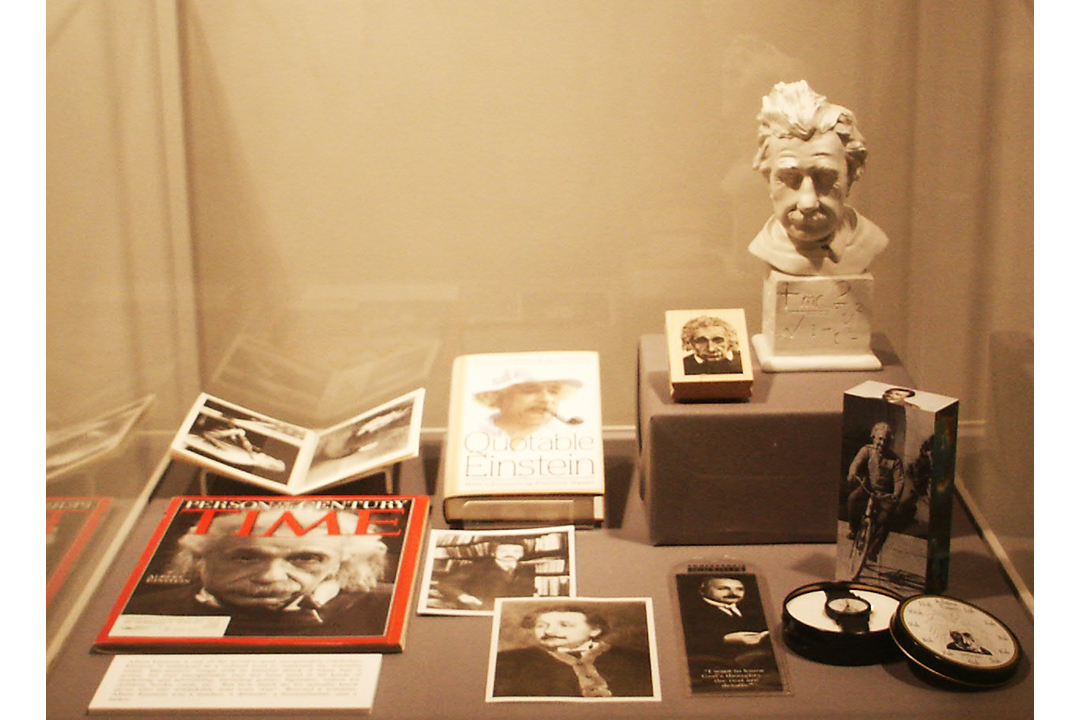
Installation view of a case in the exhibition
Merging the arts and sciences in an innovative and collaborative approach, GW has sponsored exhibitions and events throughout the year celebrating the 100th anniversary of the publication of three of Albert Einstein’s most important papers. These papers showed how to demonstrate the atomistic property of matter, launched the quantum theory of light and matter, and gave us a revolutionary new picture of space and time.
The Luther W. Brady Art Gallery will feature 14 photographs of Albert Einstein on loan from the photography collection of President and Mrs. Stephen Joel Trachtenberg and Mrs. Francine Zorn Trachtenberg. Among photographers represented in the collection are Yousuef Karsh, Lotte Jacobi, Lucien Aigner, and Alfred Eisentaedt. Einstein’s never before publicly exhibited furniture (3 pieces), on loan from the Institute for Advanced Study Historical Society of Princeton, also will also be on display throughout the exhibit. Mrs. Trachtenberg provides a narrative for the photographs on display. Finally, William Parke, GW professor of physics, assists the gallery by creatinges graphics to givethat express expression to the exhibition by combining quotations from Einstein’s and a timeline of his scientific and humanistic contributions.
Don Quijote: The Real and the Imagined
November 16, 2005-January 31, 2006
Media and Public Affairs Building, 2nd floor cases
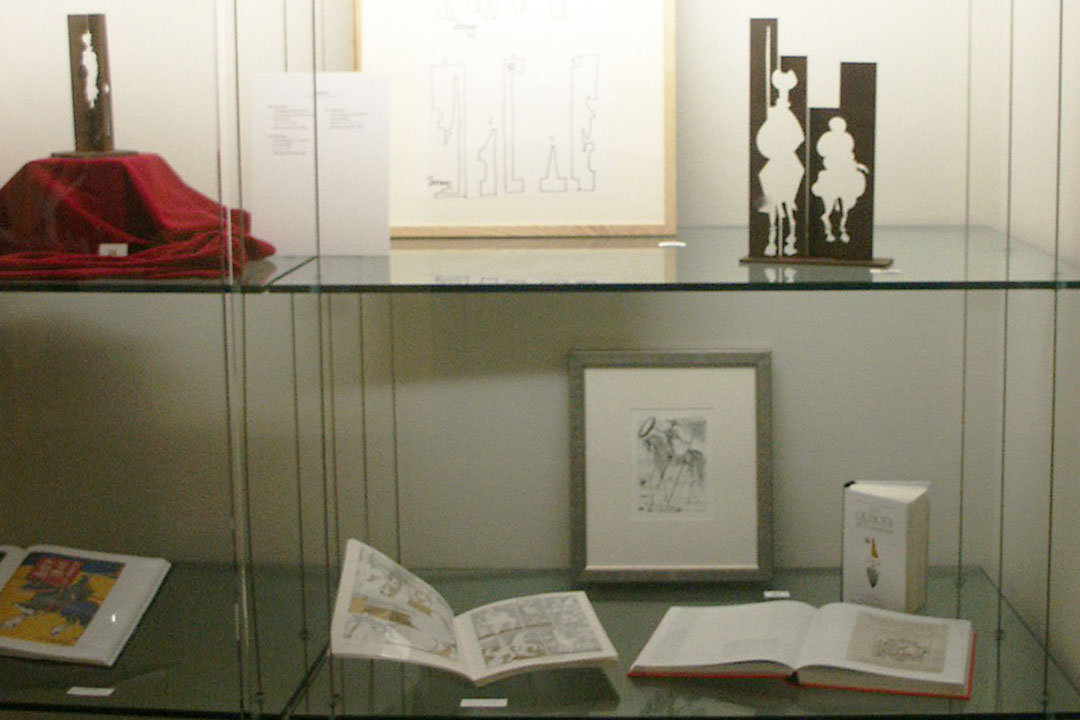
Installation view of the exhibition
Celebrating the 400th anniversary of the publication of the iconic work El Ingenioso Hildalgo Don Quijote de la Mancha, the Luther W. Brady Art Gallery is pleased to present a collection of publications and artworks based on Miguel de Cervantes’ memorable character. By combining books, sculpture, paintings and drawings, the exhibit covers the many facets of Don Quijote that have emerged from 1605 until present day. We are honored to acknowledge the co-sponsorship of the event by the Spanish Mission to the OAS (Mision Observadora Permanente de España ante la OEA) and we are grateful to the Embassy of Spain, Washington, Cultural Office for their cooperation on this exhibition. We are indebted to Professors Ellen Echeverria and Ines Azar from the Department of Romance, German, and Slavic Languages and Literatures.
Sam Gilliam: Prints from the Artist's Collection
February 8-March 31, 2006
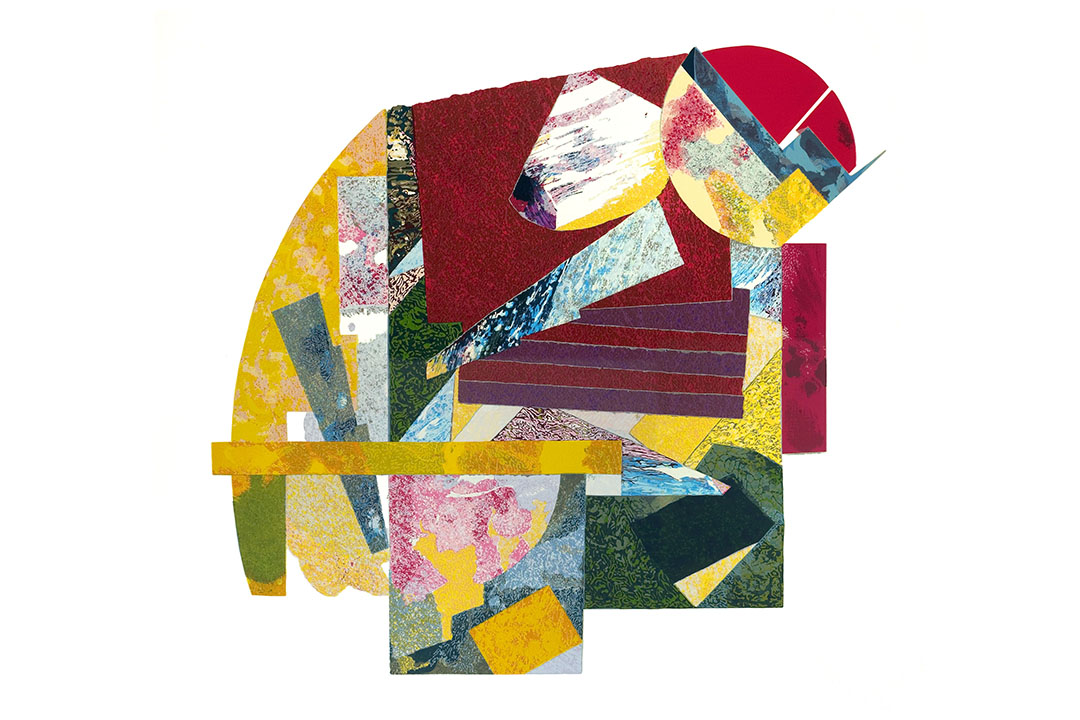
Sam Gilliam, After "Smoke"
A show of Sam Gilliam’s rarely seen prints will be exhibited in Sam Gilliam: Prints from the Artist’s Collection at the Luther W. Brady Art Gallery. In this first retrospective treatment of Gilliam’s printed works, the experimental quality seen throughout his painting career also is true of his prints. Sam Gilliam: Prints from the Artist’s Collection presents a selected, yet comprehensive, range of his printmaking oeuvre. While some of his prints exhibit the irregular shapes and bold colors so characteristic of his paintings, others are cool and minimally austere.
The exhibition of 15 works of art was organized by GW’s Luther W. Brady Art Gallery along with the Marsha Mateyka Gallery, Washington, D.C., as a complement to Gilliam’s recent retrospective at the Corcoran Gallery of Art. In a Wall Street Journal review of the retrospective Tom Freudenheim writes, “Throughout his career, Mr. Gilliam has investigated how colors interact, in the tradition of Hans Hofmann, to whom he often seems to be paying homage.”
The accompanying catalogue to Sam Gilliam: Prints from the Artist’s Collection features an essay by Ruth Fine, curator of Special Projects in Modern Art at the National Gallery of Art.
Images of George Washington in the GW Permanant Collection
February 22-October 2, 2006
Media and Public Affairs Building, 2nd floor cases
Painting, Prints, and Pottery from the GW Permanent Collection
February 22-October 2, 2006
Media and Public Affairs Building, 2nd floor cases
Annual Awards Show
April 12-28, 2006
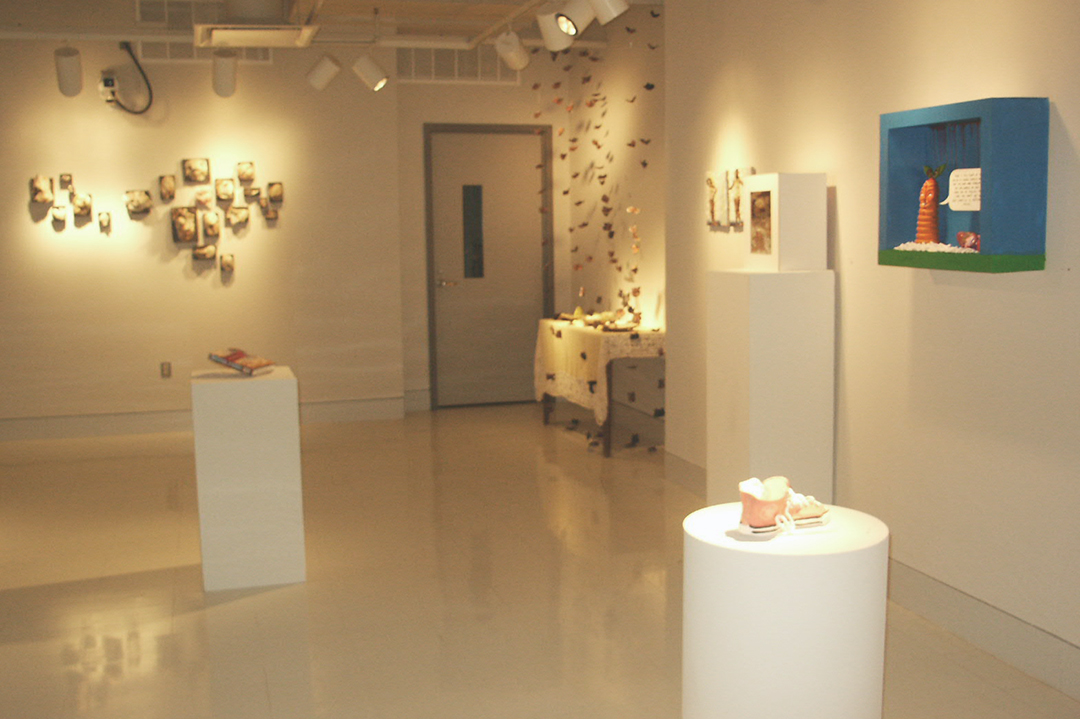
Installation view of the exhibition
An ethereal figure shifts in front of a black background. Insect forms curl on top of ceramic cylinders, and painted teabags cover the canvas symbolizing the transience of life. These are among the 26 works by emerging student artists featured in the Annual Awards Show at GW’s Luther W. Brady Art Gallery. With a diverse group of media and styles, this year’s exhibition places contemporary work in drawing and sculpture such as a sewn fabric, burlap and yarn piece, Reliquary, by Carolyne King alongside traditional ceramic work like Hilary Sloate’s mosaic panels, Fruit of the Vine.
Awards have been given for work in ceramics, design, drawing, painting, photography, and sculpture. This year’s judge is Phyllis Rosenzweig, Former Curator of Works on Paper at the Hirshhorn Museum and Sculpture Garden who also selected the works for inclusion in the exhibition.
Jules Olitski: Works on Paper
May 10-July 14, 2006
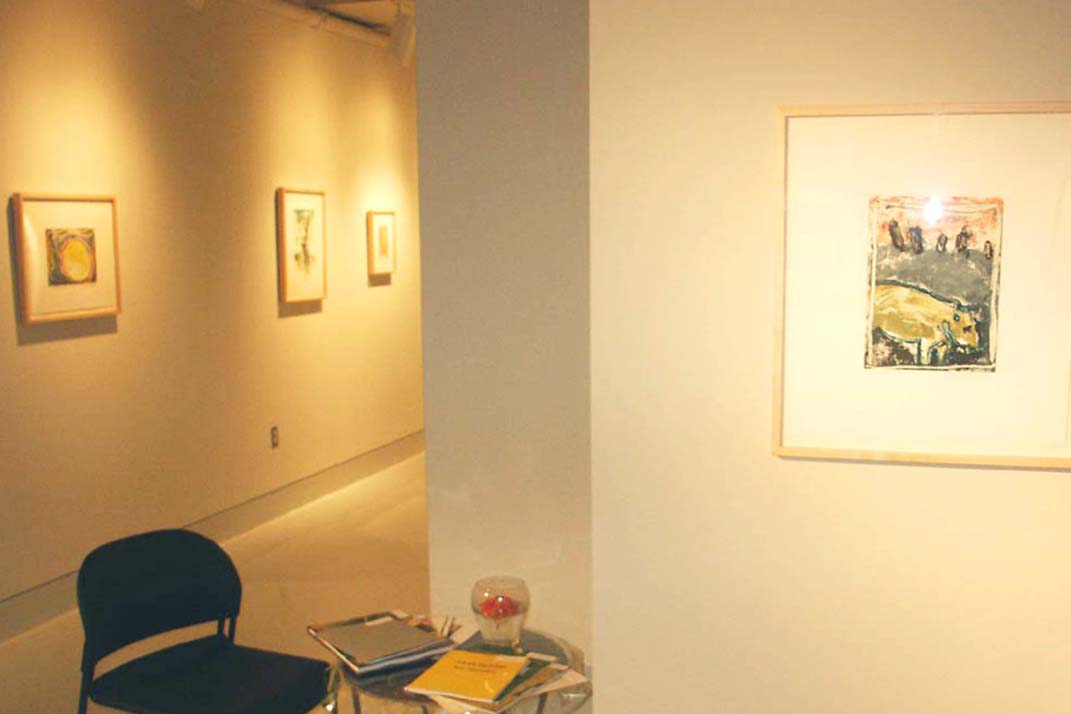
Installation view of the exhibition
Though known for his painting, Olitski’s monotypes exhibit his enormous artistic talent in a new medium. A celebrated artist, Olitski’s many honors include representing the United States in the 1966 Venice Biennale, a solo exhibition at the Metropolitan Museum of Art in 1969, election to the National Academy in 1993, induction into the American Academy of Arts and Letters on May 17, 2006 in New York City. His work is in the collections of such institutions as the National Gallery of Art, the Museum of Modern Art, the Metropolitan Museum of Art, and the Tate. Celebrated by Clement Greenberg as a great “Color Field” painter, Olitski continues undiminished with experimental use of color in his works.
In a catalogue produced by GW’s Luther W. Brady gallery, Andrew Hudson, former art critic for the Washington Post, writes “Olitski helps us recapture a child’s excited involvement, wonder, joy, delight. Instantly, eagerly, we recognize these moments of truth: his art renews us, makes us more alive.” The catalogue features a great variety of original materials, including an appreciation by Hudson, entitled “A Landscape We Already Know But Never Saw This Way Before,” and an essay by Lenore D. Miller, GW’s director of university art galleries. Jules Olitski: Works on Paper is presented in conjunction with the city-wide celebration, “Washington D.C. Celebrates American Originals” and a national campaign, where Congress has designated 2006 “The Year of the Museum.”
Recent Acquisitions to the GW Permanent Collection
October 4-27, 2006
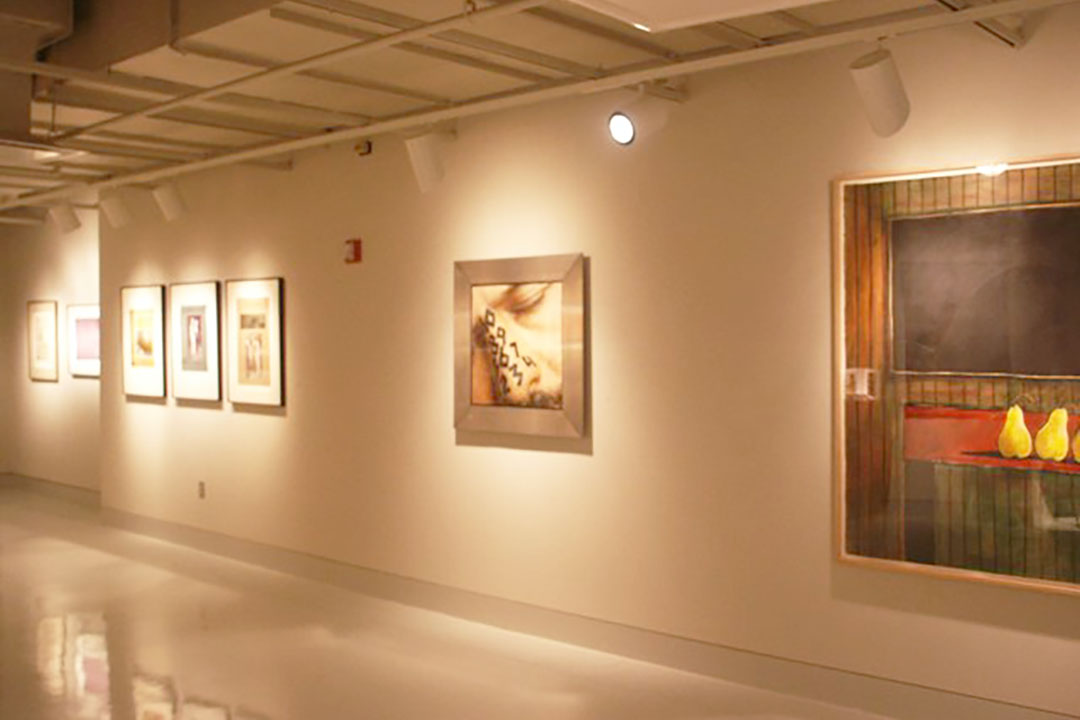
Installation view of the exhibition
Part of the educational mission of the Luther W. Brady Art Gallery is to collect, preserve, and display works of art for the University and surrounding community. As part of this effort, the gallery mounts exhibitions of art of historical and educational importance throughout the year, maintains a loan program throughout the University so more of the collection may be seen, and works to expand and improve the permanent collection. GW has collected artwork since 1821 and now owns works by such renowned artists as Rembrandt Peale, Gilbert Stuart, Marc Chagall, William Hogarth, and Sam Gilliam. With more than 3,600 works of art, the GW Permanent Collection constantly is growing through gifts and purchases.
Turning Wood into Art: A Gift from Jane and Arthur Mason to The Gelman Library
October 20, 2006-March 31, 2007
Media and Public Affairs Building, 2nd floor cases

Image Caption (Optional)
Presented in the second floor display cases in GW’s Media and Public Affairs Building, this recent gift of wood art from the collection of Jane and Arthur Mason demonstrates great craftsmanship and inspired design from a variety of artists. The artists represented in the exhibition are: Trent Bosch, Phil Brown, Dan Cunningham, Dan DeLuz, Joe Dickey, David Ellsworth, Michael Hosaluk, Bill Johnson, John Jordan, Dan Kvitka, Stoney Lamar, Bruce Mitchell, Gene Pozzesi, Allen Ritzman, Jack R. Slentz, Tim Stokes, and Jack Straka. After Dec. 23, the works will be permanently displayed on the first floor of GW’s Gelman Library.
The Franz and Virginia Bader Fund: Artists of the First Three Years
November 8, 2006-January 27, 2007
Installation view of the exhibition
Since 2002, the Franz and Virginia Bader Fund has distributed $185,000 to 10 grantees. For many of the artists the grant came at a critical juncture in their careers, enabling them to sustain a dream of self-realization through their art. The funds enabled the artists to take time off from other jobs, cover traveling expenses for exhibitions, construct new studio space, and experiment in other media. The Luther W. Brady Art Gallery exhibits the work of the first seven recipients of this unique grant. The artists in the exhibition are Alex Kanevsky, Steven Kenny, the late Kevin MacDonald (GW B.F.A. ’69), Susan Moore, Scott Noel, Charles Ritchie, and GW Visiting Assistant Professor Yuriko Yamaguchi. The exhibition is dedicated to the memory of Kevin MacDonald (1946 – 2006).
The Franz and Virginia Bader Fund was established in 2001 in accordance to the will of the late Virginia Bader to provide grants to visual artists who have reached the age of 40 and reside within 150 miles of Washington, D.C.
Envisioning the GW Campus: The Trachtenberg Years
February 7-March 9, 2007

Installation view of the exhibition
The George Washington University is filled with familiar landmarks - the tempietto in Kogan Plaza, the Jack Morton Auditorium in GW’s Media and Public Affairs Building, and the unforgettable city view atop 1957 E Street- which leave an indelible “GW” mark on visitors. Without such landmarks marking the campus, it would be difficult to discern between the University and the rest of Washington. It is therefore difficult to believe that none of these important pieces of the GW landscape existed prior to President Stephen Joel Trachtenberg’s arrival in 1988.
In its newest exhibit “Envisioning the GW Campus: The Trachtenberg Years,” the GW Luther W. Brady Art Gallery has provided a way to allow the visitor to chronicle the transformation of the GW campus into a cohesive urban environment with works of public art, green spaces, and state-of-the-art buildings.
In the exhibit opening, Trachtenberg argued that the transformation of the GW campus is a “bricks and mortar articulation of what has been going on in our classrooms and labs; a symbol of the great work our professors have done for 20 years.” He also noted that the roots GW has sunk into Foggy Bottom, pointing to the GW busts, flags, and benches scattered throughout campus give visitors a definitive GW feel.
Annual Awards Show 2007
March 28-April 2, 2007
The crumpled body of an insect peers out at the viewer, a delicately drawn landscape is more than it appears, butterflies cascade from the ceiling. The works in this year’s Annual Award Show invite contemplation by the viewer. They ask fundamental questions of what and why? A mixture of abstract and realistic works, many carry a deeper meaning than what is on the surface.
Awards have been given for work in ceramics, design, drawing, new media, painting, and photography. This year’s judge is artist Renee Stout, who also selected the works for inclusion in the exhibition.
2nd Floor Display Cases
May-Oct 2007
Media and Public Affairs Building, 2nd floor cases
Generations of the Washington Color School Revisited
May 9-October 5, 2007
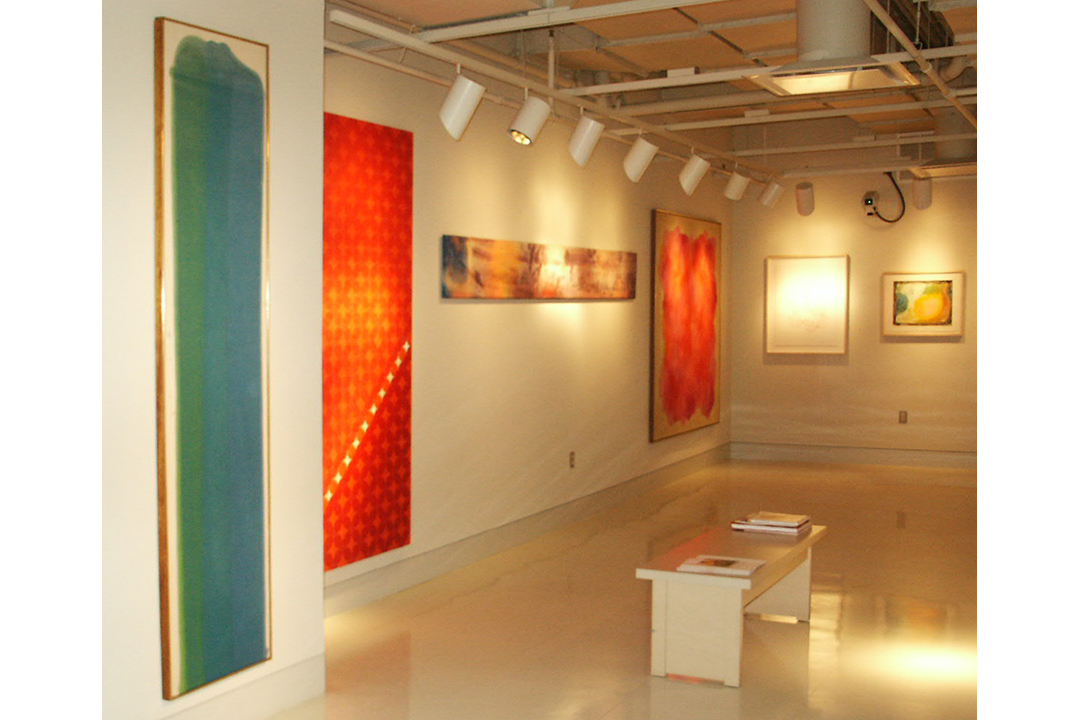
Installation view of the exhibition
The Luther W. Brady Art Gallery is participating in the city-wide event, ColorField.remix. In honor of the fifth anniversary of its dedication and in tribute of GW’s long tradition of supporting the artists and works of the Washington Color School, the Brady Art Gallery is borrowing Blue Column II, an acrylic on canvas from 1960 by Morris Louis who, along with Kenneth Noland, is credited with the founding of the Washington Color School. Drawing from its history of both exhibiting and collecting the works of artists such as Gene Davis, Thomas Downing, Howard Mehring, Alma Thomas, and Willem de Looper, the Luther W. Brady Art Gallery will build on the 1984 exhibition Generations of the Washington Color School, held at the Dimock Gallery. New additions to the GW Permanent Collection by de Looper and local artist Amy Lin will be shown along with a never before seen work by New York artist Rosette Bakish, who studied with Robert Motherwell.
In Circulation: Works on Paper
October 18-December 14, 2007

Installation view of the exhibition
A university is in a constant state of change. Students, professors, and visitors constantly cycle through the campus. Mirroring this rotation are the works of art around campus that are placed on view, taken down, and catalogued by the Luther W. Brady Art Gallery. The first step in this cycle is acquisition, when the University accepts or purchases a new work of art. Building on its growing collection of prints, photographs, and drawings, the Luther W. Brady Art Gallery exhibits some of their recent acquisitions to the GW Permanent Collection of more than 3,600 objects, including screenprints by Jules Olitski, two monoprints by Hannelore Baron, and photographs by Carl Chiarenza. Also, experimental new works based on her impressions of the Japanese painter, Sesshu (1420-1506) will be exhibited by artist, Keiko Hara. Hara currently is exhibiting other new works at the American University Museum at the Katzen Arts Center.
In addition to the exhibition, the gallery will be exhibiting the Monro-Lenox Portrait of George Washington by Gilbert Stuart and two pages from the will of George Washington on loan from Fairfax County Circuit Court in anticipation of the inauguration of GW’s 16th president, Steven Knapp.
Where There’s a Will, There’s a Way
November 12, 2007-March 31, 2008
Media and Public Affairs Building, 2nd floor cases
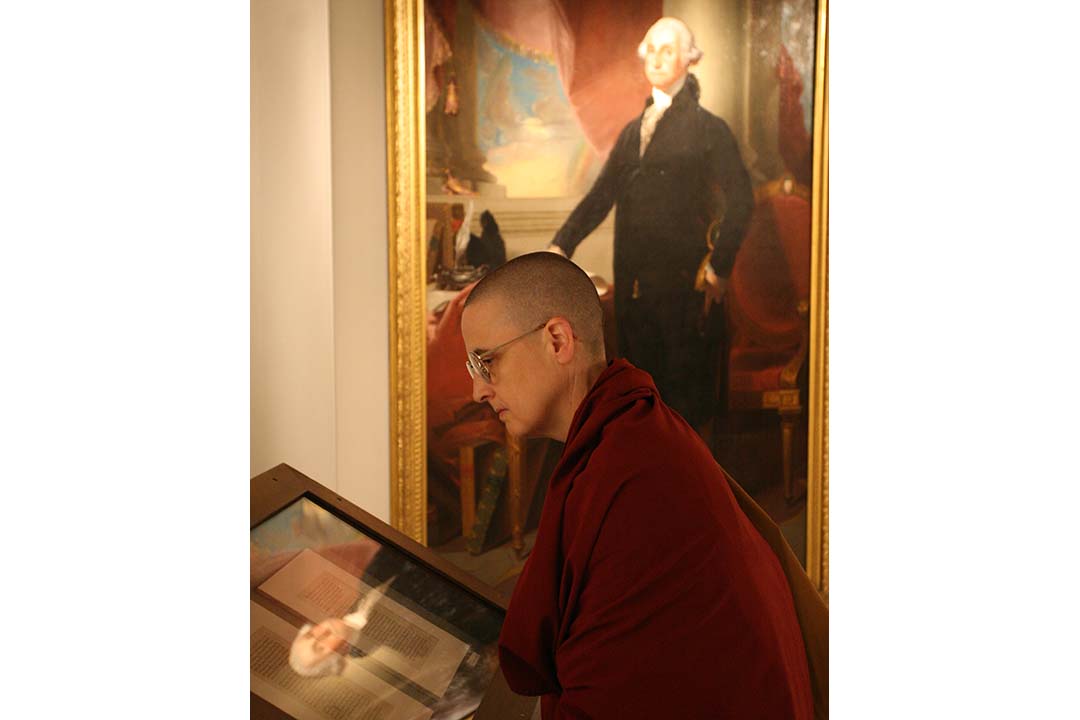
Visitor views works in the exhibition
showcase prints illustrating scenes of Washington’s life as well as a collaborative exhibit with the GW Department of Geology.
Out of the Chateau: The Demuth Museum Collection
January 16-March 14, 2008

Image Caption (Optional)
The Luther W. Brady Art Gallery will host the first-ever touring exhibition of the Demuth Museum collection, Out of the Chateau: Works from the Demuth Museum. The Demuth Museum Collection comprises more than 30 works that span the career of modernist artist Charles Demuth (1883-1935), from early childhood drawings to late floral works. Many of the works on view show the beginnings of the American Precisionist style that would bring Demuth fame as a modernist. Before joning the Demuth Museum’s permanent collection the works were long held in private hands in Lancaster, Pa., and were seldom or never publicly exhibited. While individual works have been previously lent to exhibitions at other institutions, the collection as a whole has never been seen outside of Lancaster.
In tandem with the exhibition, the Demuth Museum published the first comprehensive catalogue of the museum’s permanent collection. Also entitled Out of the Chateau: Works from the Demuth Museum, this catalogue is the first survey of any museum’s Demuth holdings to be published.
Prior to the Luther W. Brady Art Gallery, Out of the Chateau: Works from the Demuth Museum was on view at the Pennsylvania Academy of the Fine Arts in Philadelphia and will travel to several additional venues through 2009.
Annual Awards Show 2008
April 2-May 2, 2008
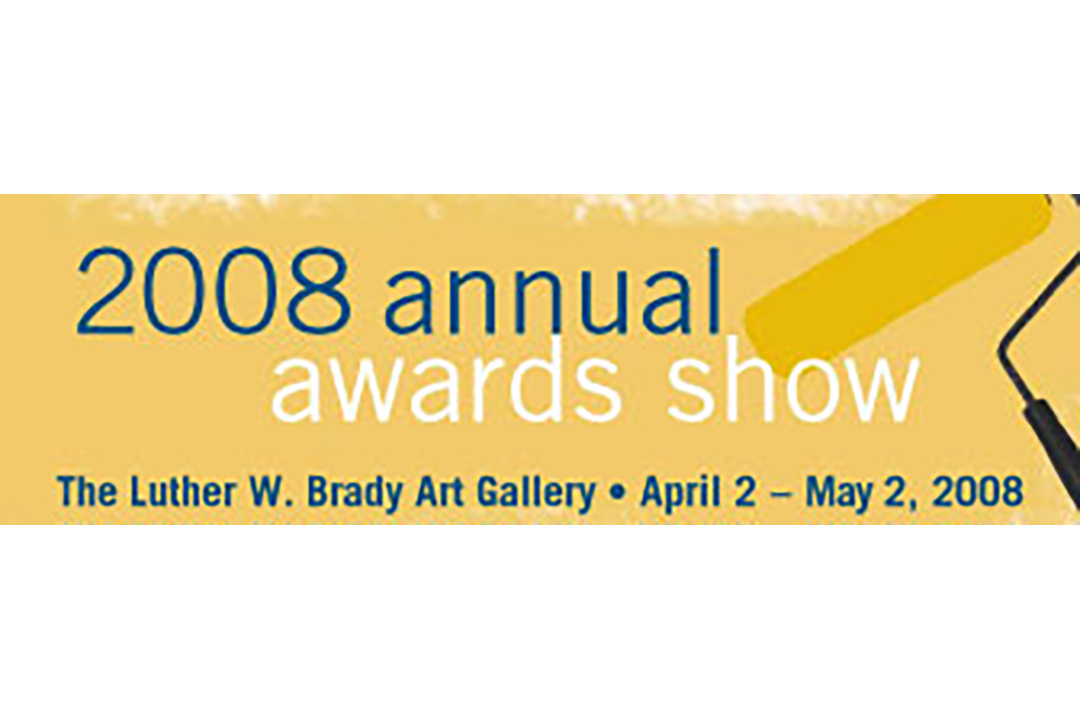
Characterized by installation art and new media works, this year’s Annual Awards Show highlights the many pedagogical directions in which the Department of Fine Arts and Art History has been engaged. From paintings of figures to a video recording Kenny George literally Chewing Up and Spitting Out Neil Diamond, the 24 works in this year’s exhibition were all produced by students who have taken a class in the Department of Fine Arts and Art History. Along with a double photograph of himself, George took first prize in the exhibition. Second prize went to Ryder Haske for photography with third prize going to Sara Hubbs for her video titled, Arizona Wall. Other awards have been given for work in ceramics, design, drawing, painting, photography, and sculpture. This year’s judge was Victoria Reis, Executive Director of Transformer. A complete list of award winners is available through the gallery.
Bringing Buddhism to America: An Exhibition of Buddhist Ritual Objects
April 14-May 30, 2008
Media and Public Affairs Building, 2nd floor cases

Installation view of the exhibition
The exhibition is co-sponsored by the Luther W. Brady Art Gallery and the GW Department of Religion. It features Buddhist religious objects in daily use in religious practice in monasteries in Tibet and in the United States, particularly from the Sakya Order of Tibetan Buddhism. The exhibition was researched and assembled by Professor Reverend Ane Kunga Chodron and undergraduate students currently enrolled in the course Tibetan Buddhism offered in the George Washington University Religion Department spring semester 2008, in order to enhance students’ hands-on experience of Tibetan religious culture and its manifestation in daily life.
Hail to the Buff and Blue: Selections from the Permanent Collection
May 14-July 11, 2008

Installation view of the exhibition
Fernando Botero’s painting, The Young Bishop is GW’s newest acquisition and a formidable addition to the University’s holdings of contemporary art. The large painting is a gift of Dr. and Mrs. Seymour Lifschutz long-time donors to the University. It is featured in the current exhibition at the Luther W. Brady Art Gallery. “Hail to the Buff and Blue” is the GW fight song. The song plays on the carillon chimes over campus every day and the crowds roar it out at sporting events. But how did the University choose those colors? Buff and blue were the colors of General Washington’s uniform and in reverence to the country’s first President, on February 22, 1905, the GW trustees declared them to be the official colors of the University. Color has meaning beyond its representational value in art and in life. It has the ability to remind us of our past experiences, move us emotionally, and possibly even bring us to a higher spiritual understanding. The works in this exhibition are all different shades of buff and blue and were chosen to demonstrate the breadth of the University’s permanent collection and how prevalent buff and blue are found in art of all eras, media, and cultures.
Stars and Stripes: The Political Flag Collection of Mark and Rosalind Shenkman
September 10-27, 2008

Visitor views works in the exhibition
The American flag was once a graphic device used in campaigning for the presidency. During presidential campaigns of the 19th century, the faces of Ulysses S. Grant, Grover Cleveland, and Theodore Roosevelt; a raccoon and the moon; tall ships; a log cabin; and platform slogans could be found on the American flag. Although the U.S. Congress decreed in 1905 that the use of text or portraits on the official insignia of the United States would be outlawed, the practice continued for a number of years.
Mark and Rosalind Shenkman, who collected almost every flag produced during this time, have loaned their collection to the Luther W. Brady Art Gallery to display during this political season. The flags, made of wool, silk, or cotton, often are one-of-a-kind surviving examples.
The Academic Tradition: Teaching and Practice
October 8-December 19, 2008
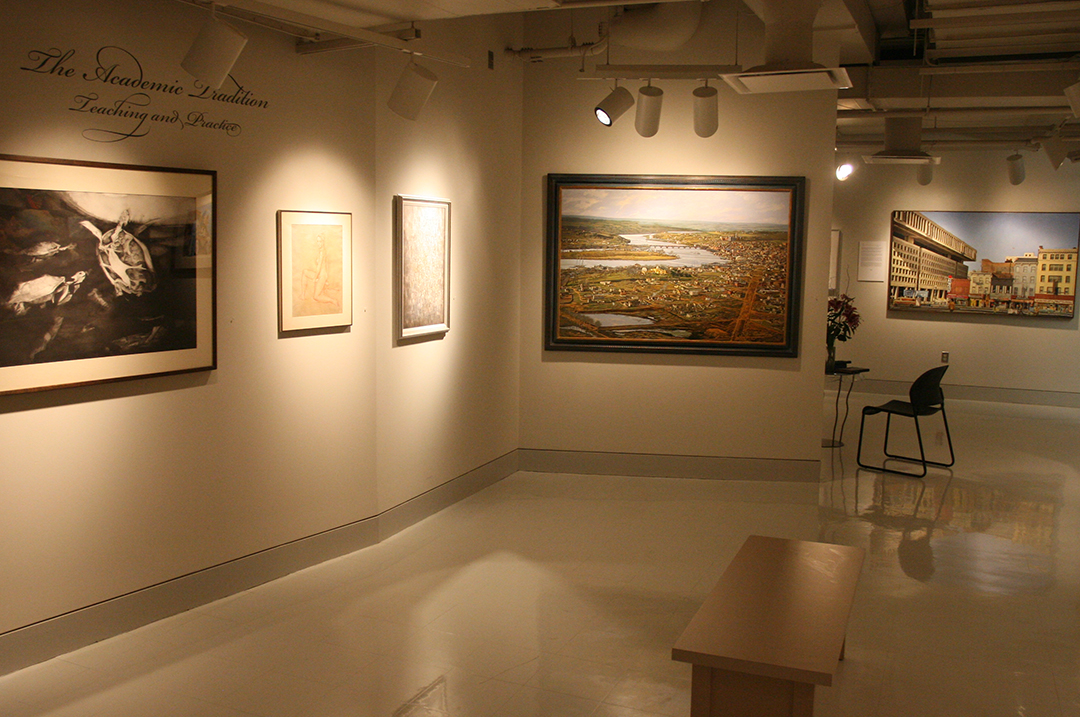
Installation view of the exhibition
This is the first in a series of three exhibitions paying tribute to the legacy of fine arts and art history up to the millennium at The George Washington University. Featured in this exhibition are artists, who are or have been, professors in the Department of Fine Arts and Art History at The George Washington University. Selected examples of their work representing subject matter pursued in the academy: history, portraiture, genre, landscape and still life are on view. The artists are Arthur Hall Smith, Clarice Smith, Douglas H Teller, William Woodward, and Frank Wright.
Under the WPA, mural painting flourished. The process of proposing and preparing studies for mural paintings is depicted in a section of the exhibition in which Guy Pène du Bois’ Study for Saratoga in the Racing Season and Berea Commencement in the Old Days, a tempera painting by Frank Weathers Long, hangs next to a preparatory drawing for a mural in process at Monticello by William Woodward.
There are two commissioned videos, one documenting four Virginia mural commissions Woodward has done and another an interview with Arthur Hall Smith in his Paris studio, also on view in the Gallery. An illustrated catalogue accompanies the exhibition.
Sarah McCoubrey: A Ten-Year Retrospective
January 14-March 13, 2009
Sarah McCoubrey’s work depicts the blurred lined where civilization meets the wilderness. The landscapes of the exhibit are populated with mundane objects such as a concrete mixer, road signs, a Weber grill, and childrens’ toys. Her images are reminiscent of those of the Hudson River School painted with the precision of Northern Renaissance panel paintings. She turns the traditional subject of landscape painting into a statement on modern society by including vestiges of human habitation.
As an associate professor at the College of Visual and Performing Arts at Syracuse University, McCoubrey has developed an appreciation for the gray northern skies in that region. Combined with her travels to Irelend, she has embraced the quality of northern light in her landscapes.
In 1988, McCoubrey’s regional exhibition, Landscape Transformed: A Washington D.C. Tradition, appeared in GW’s Dimock Gallery. Following the exhibition, McCoubrey taught in the university’s Department of Fine Arts and Art History.
Who Loves You Baby: A New York "Eclection"
April 1-May 1, 2009

Installation view of the exhibition
New Yorkers Lucy and Robert Reitzfeld are unusual in that they are collectors who also make art. Exploring the many storefront galleries to be found in New York’s East Village and SoHo during the 1980s and 90s, they came in contact with artists and art dealers, became their friends, and while producing works themselves, collected works by an eclectic group of artists active in this vibrant moment in the art world. With an aesthetic that grew out of a love for the streetscape of New York, pop culture, and the inspiration of comic art, together they sought out divergent but compatible works to collect.
The collection of seventeen paintings includes a piece by prominent DC artist Robin Rose as well as works by David Carrino, Charles Clough, David Diao, Stephen Ellis, and Melissa Meyer. Three of the paintings on view are by Lucy and Robert Reitzfeld.
Jules Olitski: An Inside View – A Survey of Prints 1954-2007
May 14-July 2, 2009
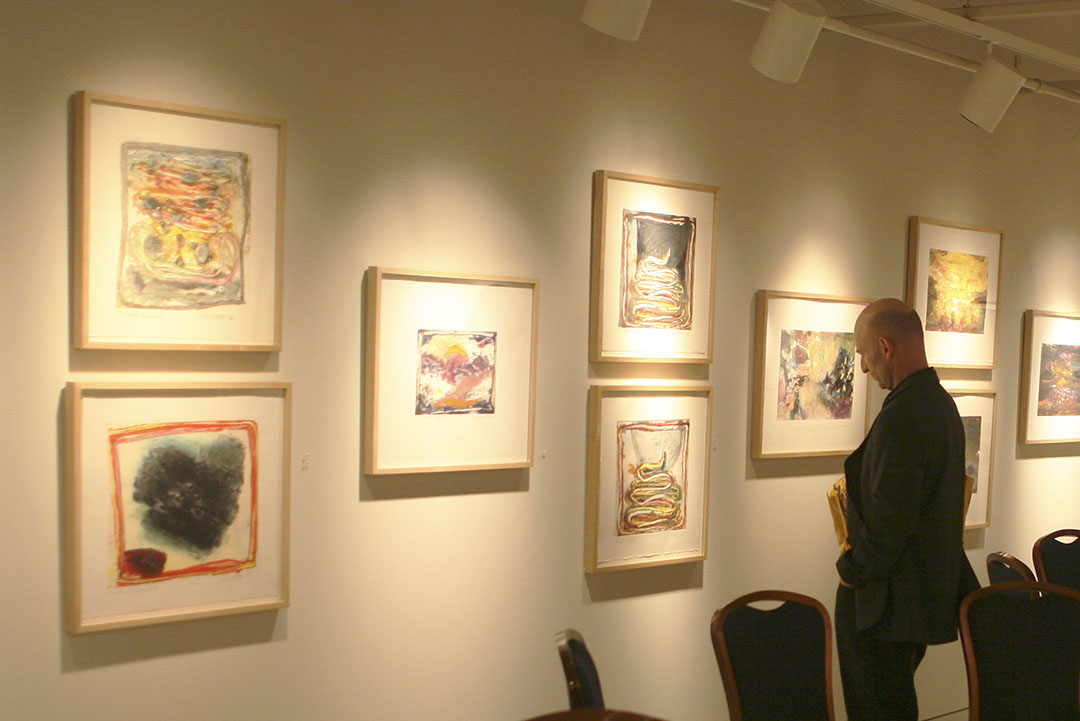
Installation view of the exhibition
“Inherent in the process of printmaking is the element of suspense,” wrote Judith Stein in the exhibition’s catalog. The more than forty prints by renowned Color Field artist Jules Olitski parallel his painting styles during his long career. Olitski began making etchings in 1956, working in both abstract and figurative modes. This retrospective of prints was organized by Brattleboro Museum & Art Center, Brattleboro, Vermont in collaboration with Knoedler and Company, New York, NY, and the Luther W. Brady Art Gallery is the third stop on a multi-city tour. Many of the works display the amazing awareness and command over color that Olitski also demonstrated in his paintings. The prints range from early self-portraits, to diaphanous screenprints from the 1970s, to intensely brilliant monotypes that were created during the last years of his life.
Nancy Graves: Inspired Vision - Sculpture, Paintings, Drawings
September 9-October 23, 2009
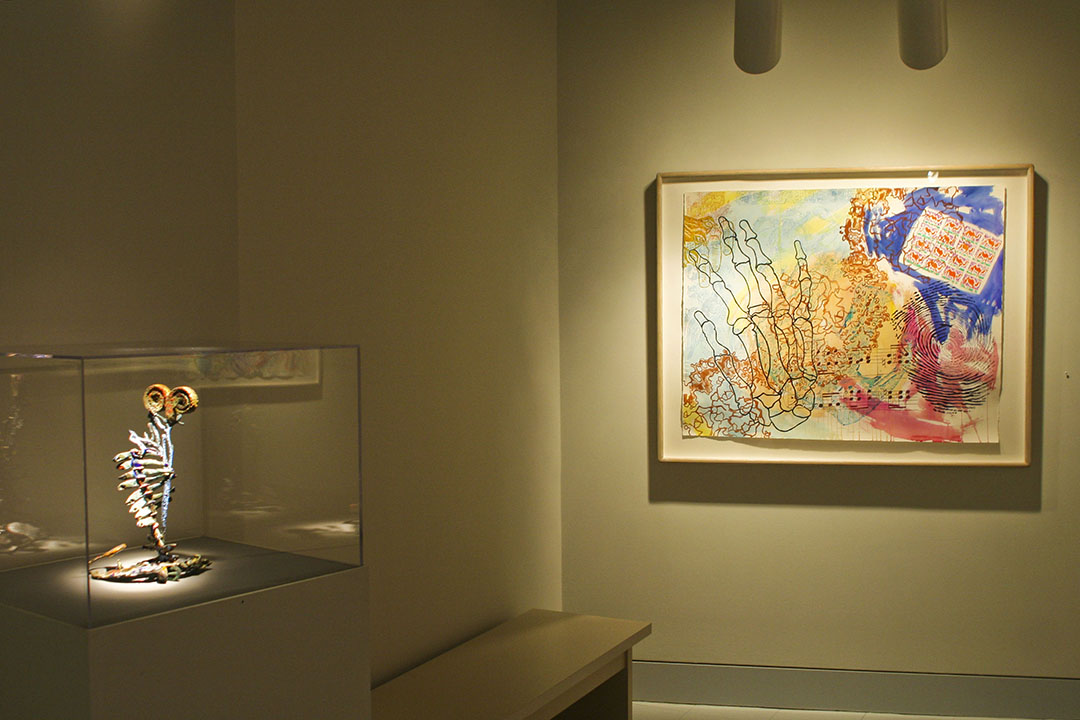
Image Caption (Optional)
The internationally recognized artist Nancy Graves (1939-1995) is mainly known for her sculpture but also produced paintings and drawings that parallel her three-dimensional work. The Luther W. Brady Art Gallery will exhibit works in all three media. The works, borrowed from the Nancy Graves Foundation of New York and the collection of Luther W. Brady, M.D., span three decades and show the artist’s use of a variety of organic and man-made sources. Each sculpture is a complex assemblage of pieces that could be found in nature joined to the art historical remnants of previous civilizations. The largest sculpture, “Herself Most Drawn,” combines a large sunflower with other natural forms while a scaley texture creeps up toward a fragment of a colorful capital. This rather weighty and bold work is balanced by a delicate suite of 12 drawings on graph paper depicting snakes, Native American costume and cave paintings. Many of Graves’ subjects were likely drawn from her interest in and study of anthropology. She is a graduate of Vassar College and received an M.F.A. from Yale School of Art. The exhibition is accompanied by a catalogue featuring an essay by Zina Davis and produced by the Joseloff Gallery, Hartford Art School, University of Hartford for their exhibition, Nancy Graves: Inspired Vision, from which our exhibition was derived.
Clothing the Rebellious Soul: Revolution 1963-1973
November 5, 2009-January 22, 2010

Image Caption (Optional)
Never-before-published vintage hippie clothing and artifacts are imaginatively displayed along with a narrative that outlines the decade 1963 – 1973 with an emphasis on portraying the political and social upheaval of the times. Van Riper was in Chicago during the riotous 1968 Democratic National Convention and covered virtually all of the racial and antiwar turmoil that occurred in major U.S. cities during that period. From his perspective, it was the first time in history that large and important cohorts of the population found their voice, most specifically young people, women and minorities.
From the Woodstock Music Festival in Bethel, N.Y. to the Haight Ashbury, North Beach and Golden Gate Park neighborhoods of San Francisco, young people celebrated with music and personal expression, hoping for an ideal world of peace and love. These places were ideal venues for people to express themselves through their clothing. Whether handmade or bought at a thrift store, these clothes incorporated Indian, Asian, African, Mexican and Native American talismans. Denim jeans became the canvas for the rebellious soul. Clothing of the 1960s was bright, colorful, unisex and personalized to express an inner angst or euphoric joy—sometimes on the same garment. Exuberant garments as a fringed leather “flag” jacket, painted jeans, vintage love beads and tee shirts with peace signs along with representative groupings of peace and protest pins will be displayed on mannequins. Rare historical ephemera from private collectors Gwen and Mark Hooper include an Earth Day flag for the first Earth Day demonstration, Black Panther Party newspapers, handbills, Milton Glaser’s Bob Dylan poster and Sister Mary Corita Kent’s Love Justice silkscreen. A “Bring the Boys Back Home” World War II helmet by a member of the Vietnam Veterans Against the War was worn at the first Moratorium March in Washington, D.C., and is one of several uniquely painted helmets which will be on display. From San Francisco, a city of dreams, to the political staging of reality in Washington, D.C., this timely exhibition melds personal adornment with media awareness of the times.

